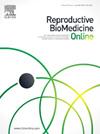EVALUATION OF THE RELATIONSHIP BETWEEN OBESITY AND OXIDATIVE STRESS IN PATIENTS WITH ADOLESCENT POLYCYSTIC OVARY SYNDROME
IF 3.7
2区 医学
Q1 OBSTETRICS & GYNECOLOGY
引用次数: 0
Abstract
Objective
Polycystic ovary syndrome (PCOS) is one of the most common diseases that starts in adolescence and is common in women of reproductive age. PCOS patients have menstrual dysfunction, signs of hyperandrogenism (such as hirsutism, acne), metabolic problems, increased cardiovascular risk, insulin resistance, risk of developing type 2 diabetes mellitus. Oxidative stress; It has high levels in patients with central obesity, insulin resistance and hyperandrogenicity. Human and animal studies on oxidative stress in insulin resistance in Turkey and in the world are insufficient. Based on this information, we aimed to obtain new data on the relationship between oxidative stress parameters, total antioxidant level (TAS), total oxidant level (TOS), and oxidative stress index (OSI) levels, with obesity in adolescence with PCOS.
Materials and Methods
Between 01.02.2021 and 01.02.2022, Amasya University Sabuncuoğlu Şerefeddin Education and Research Hospital Preferred to Gynecology and Obstetrics outpatient clinics, four groups were created, 31 normal weight and 32 overweight/obese non-PCOS; 30 normal weight and 32 overweight/obese PCOS. Rotterdam criteria was used for PCOS diagnosis. Research permission and informed consent were obtained from all patients. Blood samples were analyzed for glucose, total testosterone (TT), dehydroepiandrosterone sulfate (DHEA-S), Luteinizing hormone (LH), Follicle stimulant hormone (FSH), estrogen, progesterone, 17OH-progesterone (17OH-P), creatinine and hemogram levels. TAS, TOS and OSI were calculated with TAS and TOS kits and differences between groups were examined.
Result
Among the study groups, TT, 17OH-P, DHEA-S, WBC, CRP, ALT values, TAS, TOS and OSI were significantly higher in the obese and PCOS groups. While there is a strong correlation between TOS and OSI; there is a moderate degree between TAS and OSI. As part of the research, especially in the Obese/PCOS group patients, as the WBC value increased compared to other groups, TOS increased; TAS increased as CRP value increased; TOS increased as TT increased; As the ALT value increased, it was found that both TAS and TOS increased. A statistically significant difference in TOS and TAS values was found in the Obese/PCOS groups with Normal Weight/Normal Patient. A statistically significant difference in TAS values was found in the Obese/PCOS binary group comparison with Normal Weight/PCOS.
Conclusion
In our study, we observed changes in TOS and OSI levels in overweight/obese and non-overweight/obese adolescences with PCOS and non-PCOS. An inflammatory process in obesity was found to be effective in pathology of adolescence PCOS.
求助全文
约1分钟内获得全文
求助全文
来源期刊

Reproductive biomedicine online
医学-妇产科学
CiteScore
7.20
自引率
7.50%
发文量
391
审稿时长
50 days
期刊介绍:
Reproductive BioMedicine Online covers the formation, growth and differentiation of the human embryo. It is intended to bring to public attention new research on biological and clinical research on human reproduction and the human embryo including relevant studies on animals. It is published by a group of scientists and clinicians working in these fields of study. Its audience comprises researchers, clinicians, practitioners, academics and patients.
Context:
The period of human embryonic growth covered is between the formation of the primordial germ cells in the fetus until mid-pregnancy. High quality research on lower animals is included if it helps to clarify the human situation. Studies progressing to birth and later are published if they have a direct bearing on events in the earlier stages of pregnancy.
 求助内容:
求助内容: 应助结果提醒方式:
应助结果提醒方式:


